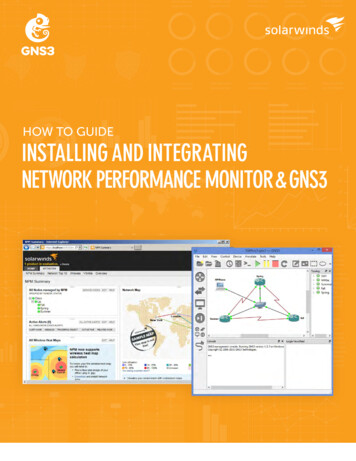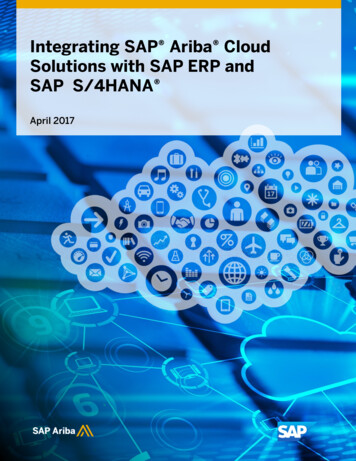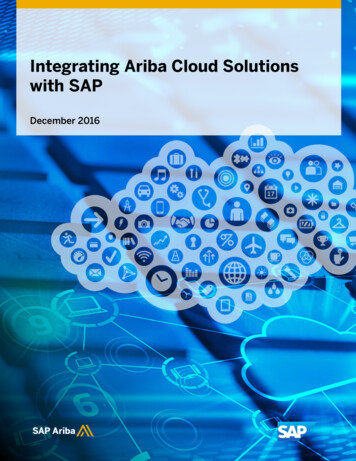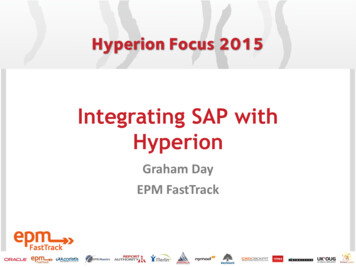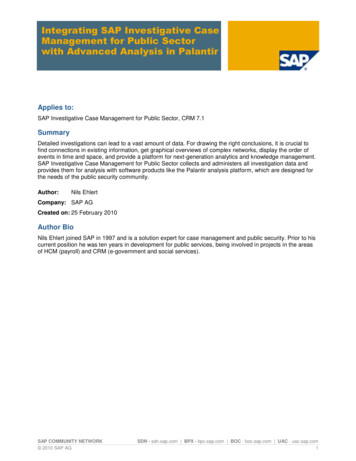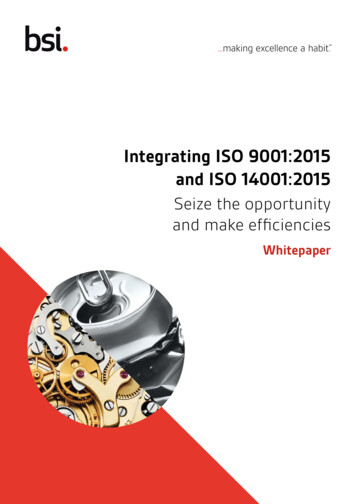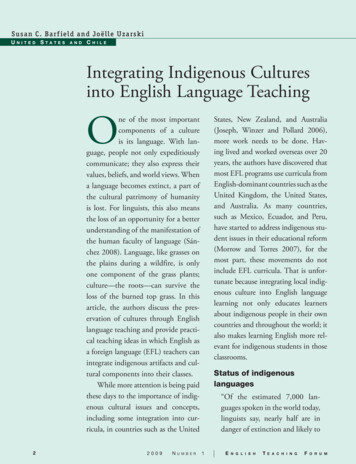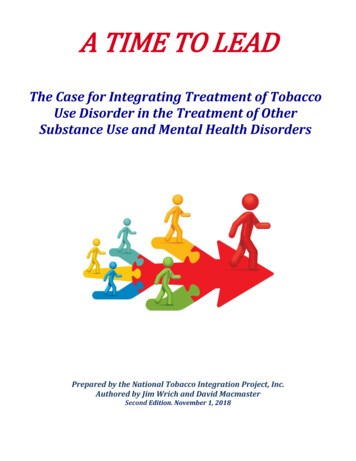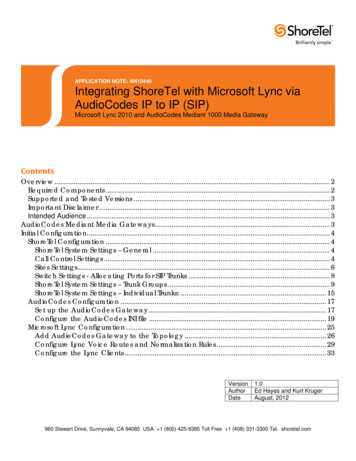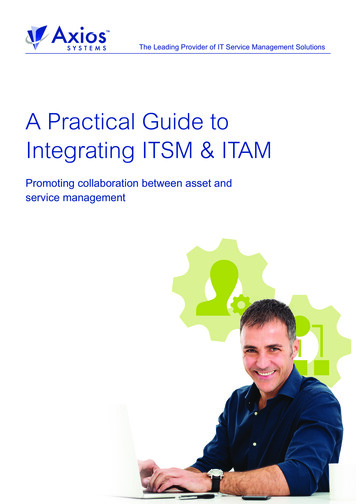
Transcription
The Leading Provider of IT Service Management SolutionsA Practical Guide toIntegrating ITSM & ITAMPromoting collaboration between asset andservice management
A Practical Guide to Integrating ITSM & ITAM: Promoting collaboration between asset and service managementExecutive SummaryIT Service Management (ITSM) and IT Asset Management (ITAM) arecomplementary disciplines with different views of the IT estate. ServiceManagement focuses on assets in the context of services, operations andbusiness value. Asset Management focuses on costs, risks, complianceand security. Where ITSM deals with the life cycles of services and supportcases, ITAM is responsible for the life cycles of underlying hardware andsoftware assets. Collectively, ITSM and ITAM form the backbone of ITInfrastructure and Operations (I&O).ITAM and ITSM add value to the organization independently of each other,however, by aligning and combining people, processes, data and tools, thematurity and value of both programs can be greatly enhanced. Through thesharing of capabilities and data and the establishment of a seamless flowof IT processes across both disciplines, IT organizations can break downsilo walls and cultivate collaboration between ITSM and ITAM – drivinggreater productivity, efficiency and transparency.This whitepaper describes the steps involved in integrating ITSM with ITAM- looking at the people, process, data and technology aspects that must beconsidered to succeed.ContentsIntroductionThe origins of IT Service ManagementThe origins of IT Asset ManagementWhat does integrated ITSM/ITAM look like?Why integrate ITSM and ITAM?The approachPeople: Driving collaborationProcesses: Integrating activityData: Sharing informationTools: Sharing & integrating platformsConclusionsAbout Axios Systems2
A Practical Guide to Integrating ITSM & ITAM: Promoting collaboration between asset and service managementIntroductionBorn of different business drivers and from different roots in the business,IT Service Management and IT Asset Management are closely relateddisciplines within I&O that are converging to solve the challenges ofenterprise IT today.Service management looks at the IT estate from a services and operationsperspective. Asset Management looks at it from an accounting and riskperspective. However, viewing an IT asset from one angle in isolation is toignore the bigger picture. If you consider the performance of an IT servicewithout looking at the cost of supporting assets, you don’t get a true pictureof value for money. Likewise, if you consider only the cost of an asset,without looking at the business value delivered, you get a very negativepicture indeed – one which fuels the image of IT as a “black hole” costcenter.So, ITSM and ITAM are complementary disciplines; two sides of the samecoin. They share many common objectives, procedures, data needs andtechnology requirements. As the two disciplines have evolved, the overlapbetween the two has reached a “critical mass” – and it is now difficult toignore the potential opportunities for efficiency and cost savings that can beachieved through integration.Cloud, virtualization, mobility, Bring Your Own Device (BYOD), social ITand other disruptive trends that have emerged over the last few yearsare making IT Infrastructure & Operations Management increasinglychallenging. The accelerating pace of business is putting pressure onIT to ramp up agility. Rigid silos and hierarchies only stand in the wayof the close collaborative that is required to deliver optimized agilityand efficiency. In a siloed IT organization, duplication of effort, data andtechnology absorbs resources and creates conflicts which put the brakeson productivity and innovation. The antidote is to break down silo walls andcreate a more collaborative culture between ITSM and ITAM. Establishingstrategic alignment, cross-functional business processes and data/skillssharing is the key to developing collaboration.In order to fully understand where we are now (and how to proceed),we must first look at the origins of IT Service Management and IT AssetManagement.3
A Practical Guide to Integrating ITSM & ITAM: Promoting collaboration between asset and service managementThe origins of IT Service ManagementIn the late 1980s, the UKGovernment’s IT bills weresoaring, so the Office ofGovernment Commerce(part of the Efficiency andReform Group) was taskedwith gathering together aset of best practices thatcould be shared to reducecosts and raise the bar ofquality across dozens ofgovernment departments.The IT Infrastructure Library (ITIL ) wasborn and began to gain traction in the1990s - first in the UK, then Europeand North America. With the rise ofthe desktop PC in the late 1980s andearly 1990s came the demand for enduser support. Where the mainframecomputer had been the sole domainof computer scientists in lab coats,technology was now in the hands of thelayman.Reactive support set the tone of ITSMfor the next decade or so until bestpractices took hold and IT departmentswere able to begin putting out fires,establish a more stable IT estate, andthink about becoming more serviceoriented, customer-oriented, andbusiness oriented.4Having access to detailed informationabout the IT estate, in the form of aConfiguration Management Database(CMDB), has been fundamental toimproving the efficiency and efficacy ofsupport – and a key enabler for anotherstep-up in ITSM maturity.The CMDB - a map of the ITinfrastructure showing IT assets andthe relationships between them (andrelationships with users) – becamethe cornerstone of good incidentmanagement, problem managementand change management. Having thisfunctional, business-oriented view ofthe IT estate – a single source of truth– has enabled improvement in almostevery ITIL process in some way.As ITSM has matured, the scopeand complexity has grown. We arenow facing the challenges of newtechnologies like virtualization, cloud,mobility and big data analytics, andof incorporating the management ofservices in other areas of the business.In organizations where ITSM is at thetop end of the maturity scale, servicemanagement practices have beenextended out to HR, Finance, FacilitiesManagement, Legal, Marketing andother departments. Having been provenwithin IT, the service managementapproach now has strategic valueacross the whole organization.Another trend, the Internet of Things(IoT), is further complicating themanagement of assets in ITSM. The“smartification” of previously “dumb”devices (like vending machines andcar pool vehicles) means IT will haveto look after a much larger set of newlydigitalized, newly connected assets;many of which carry procurement,supplier, legal and contractualimplications that are largely unfamiliarto ITSM professionals.The release of ITIL Version 3 (updatedin 2011) brought in the concept ofa Service Asset, which could bedefined as anything (a device, person,document, application or data block)that plays a part in the delivery of aservice. The scope of the term in ITILis extremely broad, which brings theIT Service Asset and ConfigurationManagement process closer to thescope of IT Asset Management – yetthere are still marked differences.
A Practical Guide to Integrating ITSM & ITAM: Promoting collaboration between asset and service managementThe origins of IT Asset ManagementThe origins of IT AssetManagement lie in theorganization’s need toaccount for rising ITcosts as data centersexpanded and desktopPCs spread throughout theorganization.The CFO naturally wanted visibilityand control over costs. Procurementprocesses were put in place to controlspending, and IT assets were managedin much the same way as othertraditional assets – accounted for asAsset Inventory on the balance sheet.If the CFO couldn’t directly quantify theROI (IT-driven increases in businessperformance have always been difficultto quantify), they would at least beaccounted for in the books. This placedITAM firmly within the view of the CFO,a situation which persists today in manyorganizations.Initially, the management of hardwareand software as assets was simple.The IT estate was small anduncomplicated. Each person wasprovided with one desktop PC and ahandful of apps – and procurement wascontrolled with water-tight processes.It was easy to track using a simplespreadsheet. But then the businessdeveloped a real thirst for productivitytools and the IT estate exploded. Therate of change accelerated beyond thepoint of control. The ITAM processesand tools of the time simply weren’t upto the job.5Ultimately, the management ofIT assets was more complex anddemanding than the management ofother (more static) business assets.Specialist IT Asset Management skillsand tools were required to keep controlover the unique aspects of managingIT assets.A broad array of “as-a-service”infrastructure offerings meansownership within the data center is nolonger mandatory (unless legislativerequirements dictate) and many of thetraditional risks that were managed bythe ITAM team have been swapped fora new set of risks.At the turn of the millennium, the Y2Kbug drove the need for full inventory ofthe IT infrastructure - to systematicallyensure that anything with an internaldigital clock would continue to operateon January 1st 2000. January cameand went and, in many organizations,the IT asset data that had beencollected was abandoned. It had servedits purpose. The opportunity to keepand maintain a complete inventory of ITassets had been passed over.On the end user side, desktopvirtualization (the “thin client” trend)has brought opportunities to simplifydesktop management and establishmore control over operating systemsand applications – by hosting virtualdesktops within the data center.In the last decade, virtualization hascomplicated IT Asset Managementeven further, both inside and outsidethe data center. We no longer see oneto-one relationships between serversand software. The need to reducecosts in the data center has driven theconsolidation of many applications ontoeach server – creating new challengesfor software license tracking andcompliance.Virtualization has also given riseto viable cloud computing models.Processing and storage can nowbe done without ownership of thesupporting assets, which changes theITAM dynamic significantly. Softwareas-a-Service (SaaS) applications arerented, not owned, so they don’t qualifyas assets in the classical sense.Assets are now less tangible, bringingnew management challenges for ITAM,especially when it comes to licenseauditing. The mobility and BYOD trendare further complicating the situation.ITAM teams now have to deal witha plethora of non-standard devicesowned by end users, making it moredifficult to track what they are, wherethey are, and which software is in use.These new challenges are collectivelyblurring the lines between ITAM andITSM. We have reached a point wherethe two disciplines must work moreclosely together to deliver for thebusiness and prevent IT operationscosts from spiraling out of control.
A Practical Guide to Integrating ITSM & ITAM: Promoting collaboration between asset and service managementWhat does integrated ITSM/ITAM look like?Integrating ITSM and ITAMisn’t about merging teamsor departments.It’s about facilitating closer collaborationbetween two distinct IT disciplineswhich are well established andsupported by mature best practiceslibraries (ITIL for ITSM and IBPLfor ITAM). Your ITSM and ITAMframeworks will both continue to exist.The shape of your teams will remainthe same. Reporting lines won’tchange. Cooperation, collaboration andtransparency are the key words here. Integrating ITSM and ITAM means: Aligning the two programs at themanagement level. Getting ITSMand ITAM heads in the same roomand on the same page. Building relationships betweenpeople at all levels within bothteams. Pooling people, skills, expertise,tools and data, and making themavailable to both programs. Educating Service Managementteams about Asset Managementand vice-versa.6 Formally integrating IT processesto combine ITSM and ITAMcapabilities. Processes shouldn’tbe constrained by departmentalwalls when capabilities exist justacross the hall.Working together to build a morecomplete picture of the IT estate,what it does, what it costs (bothprocurement and operations) andwhere the potential risks lie.Presenting a single unifiedinterface to the end usercommunity through a singleservice desk and a single IT portal/service catalog. The customersof IT Service Management arealso the customers of IT AssetManagement.Co-planning innovations that willdrive the business forward.What the integration of ITSM and ITAMisn’t about: Forcibly consolidating teams toreduce staff numbers. Consolidating ITSM and ITAMtools to satisfy the need for costreduction. An aggressive takeover of ITAMby the ITSM team (or vice-versa).That’s a hornet’s nest you definitelydon’t want to kick. Stripping people of their ITSM orITAM “identity”.
A Practical Guide to Integrating ITSM & ITAM: Promoting collaboration between asset and service managementWhy integrate ITSM & ITAM Break down silo walls andestablish a more collaborativerelationship between ServiceManagement and AssetManagement. Open a window between the twodisciplines to improve the ITSMteam’s understanding of cost,risk, governance and complianceissues. Draw on ITSM tools and expertiseto support more efficient andeffective ITAM processes.Leverage ITAM tools and expertisein support of better outcomes fromITSM processes. Likewise, improve the ITAM team’sunderstanding of the value of ITassets in the context of IT servicesand business services. IT Asset Management iscommonly an underestimated andunderfunded program. PuttingITAM on the same stage as ITSMwill help bring it under the spotlight. Reduce costs by eliminating effortand spend that is duplicatedacross the two disciplines. Share infrastructure and operationsdata for more efficient processes inboth areas. Integrating ITSM and ITAMimproves the maturity of bo
The CMDB - a map of the IT infrastructure showing IT assets and the relationships between them (and relationships with users) – became the cornerstone of good incident management, problem management and change management. Having this functional, business-oriented view of the IT estate – a single source of truth – has enabled improvement in almost every ITIL process in some way. As ITSM .

